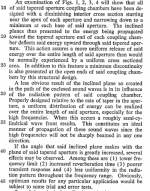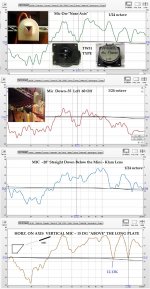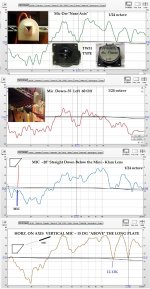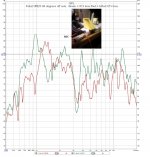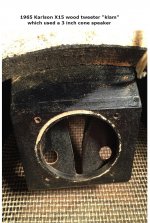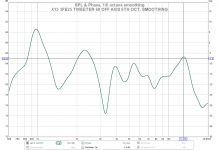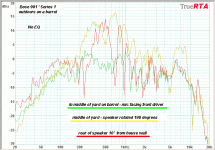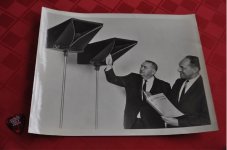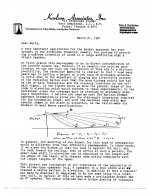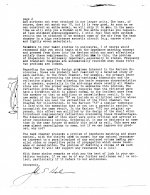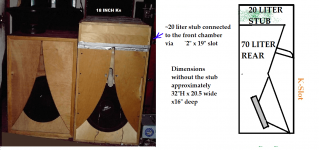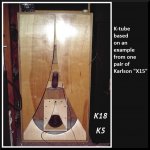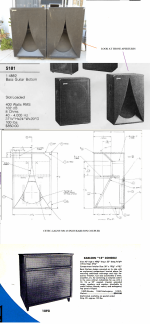hey IG81 - John Karlson lined both sides that K12 cabinet's rear chamber with fairly thick pads of "Kimsul" (- a Kimberly-Clark wall insulation product popular with speaker cabinet manufacturers such as Bozak in its day.)
Do you think lining the back chambers sides as in the K12 picture above would have any positive effect graph-wise?
One feature that Karlson spoke of was "controlled-ring" / reverberation.
Do you think lining the back chambers sides as in the K12 picture above would have any positive effect graph-wise?
One feature that Karlson spoke of was "controlled-ring" / reverberation.
Attachments
Last edited:
keantoken, here is the file with the previous data group.
freddi, I lined my rear chamber well enough with felt, I probably have a reasonable effect as with other vented enclosures.
I have this single 8" ceiling fullrange with whizzer, called Enforcer-8. I meaured Fs~90Hz and Qts~1.7. It loosely fits the hole for the 830869 so put it in the TK6 for fun. There is probably a bit of leakage around the frame, not necessarily a bad thing with this high Qts. It sounds way better than I expected. I punched a hole in the cone when my screwdriver slipped, luckily on this cheap driver. It is quite old and the paper is super dry. I applied a small piece of paper towel with diluted PVA glue to patch it.
freddi, I lined my rear chamber well enough with felt, I probably have a reasonable effect as with other vented enclosures.
I have this single 8" ceiling fullrange with whizzer, called Enforcer-8. I meaured Fs~90Hz and Qts~1.7. It loosely fits the hole for the 830869 so put it in the TK6 for fun. There is probably a bit of leakage around the frame, not necessarily a bad thing with this high Qts. It sounds way better than I expected. I punched a hole in the cone when my screwdriver slipped, luckily on this cheap driver. It is quite old and the paper is super dry. I applied a small piece of paper towel with diluted PVA glue to patch it.
Attachments
(I've used coffee filter paper for repairs on some better condition cones)
FWIW here's the general behavior of the1-inch throat micro klam whose 3D print file was made by Pelanj.
I don't think the multi-way folks would like it and probably not of interest for
FR people either. BUT its something I think kinda neat. Alan Weiss (whom I understand worked with John Karlson in later times) patented (now expired) the micro-klam within a multi-channel patent. Alan had a home theatre system with four 2-way speakers and a subwoofer. Each speaker had 1- Eminence Beta 8A woofer and a one-inch format sheet metal nicro klam. The micro-klam's driver was Eminence's CD1 ("type 1" with aluminum diaphragm-limited to ~13KHz but considered by some to have better sound quality than the later titanium version)
At Job Ulfman's old Karlson forum I saw a few blurry pictures of Alan's theatre speakers. They had direct radiator woofer - direct radiator midrange- and metal klam compression driver lens. (not sure if 1" or 1.4" format -?) Peavey's J. Risch heard them - maybe as something Peavey might market and said the tweeter "sprayed highs everywhere" -thus not meeting THX standards for movie theatre work. There was a story that Alan's speakeres were destroyed right befor a showing with ball bats by "THE MOB" (!) but that posting was before I joined Job's K-forum.
The driver on the baby klam lens below is a 4 ohm sqaure plate version of Audax's TW51 type.
Here's a general first hand look of the1 dollar (but excellent driver) sliced/diced and sprayed by the little K-lens. With the klam's long plate at the top, It should be placed above ear level and fire down/forwards. There's a fair amount of energy below and perhaps up to "90"off horizontal. The baffle tilt makes it tough to describe.
I'm really weak and outta breath so this is all for 2might.
FWIW here's the general behavior of the1-inch throat micro klam whose 3D print file was made by Pelanj.
I don't think the multi-way folks would like it and probably not of interest for
FR people either. BUT its something I think kinda neat. Alan Weiss (whom I understand worked with John Karlson in later times) patented (now expired) the micro-klam within a multi-channel patent. Alan had a home theatre system with four 2-way speakers and a subwoofer. Each speaker had 1- Eminence Beta 8A woofer and a one-inch format sheet metal nicro klam. The micro-klam's driver was Eminence's CD1 ("type 1" with aluminum diaphragm-limited to ~13KHz but considered by some to have better sound quality than the later titanium version)
At Job Ulfman's old Karlson forum I saw a few blurry pictures of Alan's theatre speakers. They had direct radiator woofer - direct radiator midrange- and metal klam compression driver lens. (not sure if 1" or 1.4" format -?) Peavey's J. Risch heard them - maybe as something Peavey might market and said the tweeter "sprayed highs everywhere" -thus not meeting THX standards for movie theatre work. There was a story that Alan's speakeres were destroyed right befor a showing with ball bats by "THE MOB" (!) but that posting was before I joined Job's K-forum.
The driver on the baby klam lens below is a 4 ohm sqaure plate version of Audax's TW51 type.
Here's a general first hand look of the1 dollar (but excellent driver) sliced/diced and sprayed by the little K-lens. With the klam's long plate at the top, It should be placed above ear level and fire down/forwards. There's a fair amount of energy below and perhaps up to "90"off horizontal. The baffle tilt makes it tough to describe.
I'm really weak and outta breath so this is all for 2might.
Attachments
Thanks for that info, I was wanting to see some information on that. It seems the k-tube may be more amenable to smooth response.
Maybe Karlson sent the mob after Ulfman? 😀
Maybe Karlson sent the mob after Ulfman? 😀
freddi,
I posted it in my "TK6 + K-Tube" thread over in Multi-Way, but check out my latest measurements of various tubes I DIY'ed. I equalized a TPC-clone roughly for its power response and it worked well.
Tube measurements
I posted it in my "TK6 + K-Tube" thread over in Multi-Way, but check out my latest measurements of various tubes I DIY'ed. I equalized a TPC-clone roughly for its power response and it worked well.
Tube measurements
Your setup was good, so the measurements were already time aligned. 2mm is about 6uS which doesn't matter much when you BW is 5KHz.
Try this. In the impulse response tab, click and drag the blue "ref" tag at the top of the impulse chart. This will allow you to move the window. You can then scope out reflections. Note that in between two reflections there is usually a notch at some frequency or multiple frequencies. If you click on the gear in the upper right you can turn on "show magnitude graph" to keep it from disappearing when you let go of the blue tag. I have set the IR windows to work better on reflections.
Try this. In the impulse response tab, click and drag the blue "ref" tag at the top of the impulse chart. This will allow you to move the window. You can then scope out reflections. Note that in between two reflections there is usually a notch at some frequency or multiple frequencies. If you click on the gear in the upper right you can turn on "show magnitude graph" to keep it from disappearing when you let go of the blue tag. I have set the IR windows to work better on reflections.
Attachments
LOL-Karlson died January of 1973. Alan Weiss's speaker showing must have been "sabotaged" and klobbered with ball bats around the year 2000 (K's ghost??? 😀) perhaps I can contact Job Ulfman to see if he remembers the gist of Alan's post.
From what I understand from communications with the late Martin Poppe ("The K-Coupler" was his thesis paper) and from Alan Weiss's Karlson Speaker Project forum posts, that Alan was an assistant to John Karlson and helped install the large klam-projectors (assume Karlson-AP100/Karlson-Oliver Magna-Clam) at Radio City Music Hall.
I really like my 15 inch klam -with `38 degrees aperture tilt relative to horizontal, its shorter than the AP100 and would be shorter still as its back chamber volume is larger than needed for its Eminence 15CX (it was playing in this video with an extended K-tube crammed down the treble horn)
From what I understand from communications with the late Martin Poppe ("The K-Coupler" was his thesis paper) and from Alan Weiss's Karlson Speaker Project forum posts, that Alan was an assistant to John Karlson and helped install the large klam-projectors (assume Karlson-AP100/Karlson-Oliver Magna-Clam) at Radio City Music Hall.
I really like my 15 inch klam -with `38 degrees aperture tilt relative to horizontal, its shorter than the AP100 and would be shorter still as its back chamber volume is larger than needed for its Eminence 15CX (it was playing in this video with an extended K-tube crammed down the treble horn)
Karlson's 1st X15 2-way speaker had an open-ack 3 inch cone speaker on a little wood mini - "klam". It attached to the tilted baffle. The back chamber was a styrofoam coffee cup.
As a super wonderful Christmas gift, I received a box of various 3D printed K-goodies from Pelanj. Included was a replica x15 tweeter klam and modified "lofted" version with curved internal surfaces.
Here's a graph using a 3fe25 with the mic about 60 degrees or more off axis relative to the orientation shown in the embedded blurry picture. I'm surprised to see a large difference but
the lofted version has significantly less internal volume due to very thick curved walls.
In Karlson's X15, some energy was firing up against the 3 panel upper reflector, some fired left and right against the back of the wings, etc.
K-builder Carl Neuser liked a particular Eminence made woofer sold by Martin under 15169. That woofer won't go above 800Hz and is less sensitive than the kind I generally use but it can move some air. I think this mini klam - or perhaps IG81's V-slot type tube could make a fun tweeter with the15169 (Eminence #151269 IIRC)
Those are 2dB vertical increments so not as horrific as may seem.
3fe25 sounds pretty peppy on sine sweeps.
Here's the same data 1/6 octave
BTW, Karlson's wood klam-lens had two holes near the tight portion of thes - slot
-- did they correct for some peak ?
As a super wonderful Christmas gift, I received a box of various 3D printed K-goodies from Pelanj. Included was a replica x15 tweeter klam and modified "lofted" version with curved internal surfaces.
Here's a graph using a 3fe25 with the mic about 60 degrees or more off axis relative to the orientation shown in the embedded blurry picture. I'm surprised to see a large difference but
the lofted version has significantly less internal volume due to very thick curved walls.
In Karlson's X15, some energy was firing up against the 3 panel upper reflector, some fired left and right against the back of the wings, etc.
K-builder Carl Neuser liked a particular Eminence made woofer sold by Martin under 15169. That woofer won't go above 800Hz and is less sensitive than the kind I generally use but it can move some air. I think this mini klam - or perhaps IG81's V-slot type tube could make a fun tweeter with the15169 (Eminence #151269 IIRC)
Those are 2dB vertical increments so not as horrific as may seem.
3fe25 sounds pretty peppy on sine sweeps.
Here's the same data 1/6 octave
BTW, Karlson's wood klam-lens had two holes near the tight portion of thes - slot
-- did they correct for some peak ?
Attachments
Last edited:
Since so many problems are caused by the cavity response of the aperture, I was looking a the Klam (not mini klam) and wondering why not just delete the wall below the aperture so that the sound bouncing off of it just goes out into the room in another direction? Outside the sound would just go into the sky. A big waste perhaps, but also an interesting experiment?
Hi keantoken
removing that wall would be interesting. With larger K such as K12 and K15, I believe the front chamber is beneficial as it supports the harmonic areas of common bass instruments and drums thus reducing cone excursion on loud transients. K15 can play some jaw-dropping stuff without much if any visible cone movement.
Bose with the 901 tolerated dips and peaks. Here's my 901 Series I outdoors (no EQ) from front rear and rear bounced perspectives.
FWIW Karlson did not want absorbent materials in the front chamber. The Karlson - Oliver Phase III klam has a thin sheet of acrylic cemented to its long wall.
removing that wall would be interesting. With larger K such as K12 and K15, I believe the front chamber is beneficial as it supports the harmonic areas of common bass instruments and drums thus reducing cone excursion on loud transients. K15 can play some jaw-dropping stuff without much if any visible cone movement.
Bose with the 901 tolerated dips and peaks. Here's my 901 Series I outdoors (no EQ) from front rear and rear bounced perspectives.
FWIW Karlson did not want absorbent materials in the front chamber. The Karlson - Oliver Phase III klam has a thin sheet of acrylic cemented to its long wall.
Attachments
Last edited:
We don't have to do everything Karlson did. We might make the same mistakes. 🙂
It's interesting to see his reasoning on the curved panels though. I wonder what happens if we curve the aperture panels instead of the baffle? Or remove the reflector panel on the baffle and cut a hole above it so that energy can just go up?
It's interesting to see his reasoning on the curved panels though. I wonder what happens if we curve the aperture panels instead of the baffle? Or remove the reflector panel on the baffle and cut a hole above it so that energy can just go up?
keantoken,
I got to have a look at the narrow-window IR plot for my TK6. I can see the varying FR and phase response over time, though I'm not to certain how to diretctly explain the sudden phase shift, but it might just be that transition from the K-slot being seen as the radiator at longer wavelengths to the actual speaker element direct-radiating above this.
I got to have a look at the narrow-window IR plot for my TK6. I can see the varying FR and phase response over time, though I'm not to certain how to diretctly explain the sudden phase shift, but it might just be that transition from the K-slot being seen as the radiator at longer wavelengths to the actual speaker element direct-radiating above this.
XRK971 curved the top portion of one build with improvements I can't find it in my drive but it's probably in his XKi thread.
I've played a wide variety of music through K15 with coaxial - opera - lieder - rock -rap -jazz organ -percussion, and with pretty good result. I think my K18 with curved reflector "may" be better but never ran it with a 15CX - just 18" woofer + mis-matched diameter K-tube. IF theres any reasonably low mass 18 inch speakers available then a K18 with internal 1.4" compression driver K-tube might be pretty impressive. Eminence's Sigma would be OK.
I've played a wide variety of music through K15 with coaxial - opera - lieder - rock -rap -jazz organ -percussion, and with pretty good result. I think my K18 with curved reflector "may" be better but never ran it with a 15CX - just 18" woofer + mis-matched diameter K-tube. IF theres any reasonably low mass 18 inch speakers available then a K18 with internal 1.4" compression driver K-tube might be pretty impressive. Eminence's Sigma would be OK.
Is your K18 smaller than a 1.2x scale-up from K15? I think that keeping the woofer large relative to the front chamber width, depth and volume is a good thing. It's not a horn, but I think the behavior is horn-like in the sense you don't design a front horn for a 10" and stick a 6" in it. It's only anecdotal, but the best I got my TK6 to sound yet with with a 8" woofer with good specs, even an 8" fullrange with high Qt. I also remember the best my K5 sounded was with a Vifa C13 5.25" midbass, versus the FF125K or copy of Pioneer A11. I wish I had tried the Celestion TF1020 in the SK8 - which really is a K10 IMO - and a good pro 12" in the Karlsonette. I only used 8" and 10" drivers in it, though the TF1020 did do quite well.
I found your K18 dimensions from another post: 41.5" H x21.5"W x 16"D. 1.2x scaled-up K15 would be: 39.5" x 27" x 21.6". So your K18 is only slightly bulkier than K15 and about the same width, which I'd argue would most define a nominal K-size. I think its smooth graph is partly explained by the seemingly lower driver constriction. Maybe anecdotal again, but it's another low ratio of driver to front chamber width that appears successful.
The tall K18 was just a bit bulkier than K15. It sounded very good with any of my 18 inch speakers.
Outdoors meaurement with heavier drivers showed about a 1dB peak around 80Hz. I'd like to see its height reduced to 36 inches for better aesthetics.
The little K18 where I used a 1.2" starting gap to get it sounding right was 32" tall, about 20.5" or 21" wide and either 15" or 16" deep. It had roughly a 70 liter back chamber. It was made simple
like a "big K12". For experiments I screwed on a 20 liter stub chamber connected to the top of the front chamber by a 2" by 19" slot. That smoothed the response ripple and leveraged maybe 2dB more bass. 70 liters rear chamber was sufficient for the 0.25 qts Eminence 18" speaker.
I cut ~3" off the top of the wings to raise them -really no improvement in sound quality but some clearance for the parabolic slot K-tube.
FWIW I'd guess my 41.5" tall K18 has a more forwards midrange than K15 due to the curved
upper reflector and smooth resultant graph.
My first "K18" was an attempt at Karlson's "Fig.6" with 15" speaker from patent 3540544. I think the cavity was just too deep. A front shelf made it play and sound close to K15. I somehow took a jigsaw and re-cut the baffle for an 18" Emiennce. That was real fun - mellow with good power to probably 60Hz and cannonball punch.
Outdoors meaurement with heavier drivers showed about a 1dB peak around 80Hz. I'd like to see its height reduced to 36 inches for better aesthetics.
The little K18 where I used a 1.2" starting gap to get it sounding right was 32" tall, about 20.5" or 21" wide and either 15" or 16" deep. It had roughly a 70 liter back chamber. It was made simple
like a "big K12". For experiments I screwed on a 20 liter stub chamber connected to the top of the front chamber by a 2" by 19" slot. That smoothed the response ripple and leveraged maybe 2dB more bass. 70 liters rear chamber was sufficient for the 0.25 qts Eminence 18" speaker.
I cut ~3" off the top of the wings to raise them -really no improvement in sound quality but some clearance for the parabolic slot K-tube.
FWIW I'd guess my 41.5" tall K18 has a more forwards midrange than K15 due to the curved
upper reflector and smooth resultant graph.
My first "K18" was an attempt at Karlson's "Fig.6" with 15" speaker from patent 3540544. I think the cavity was just too deep. A front shelf made it play and sound close to K15. I somehow took a jigsaw and re-cut the baffle for an 18" Emiennce. That was real fun - mellow with good power to probably 60Hz and cannonball punch.
Attachments
Last edited:
freddi,
Regarding K18, I don't know if you recall, but many years back, possibly in 2013 or so, I 'discovered' yet another possible licensee of Karlson tech who'd made a K18 IIRC and emailed the guy from the company whose names I both forget, for some info, some of which was provided. I think it was geared towards pro-sound application, no so much home hi-fi. I might have posted this over on Gainclone or Fullrangedriver.com, maybe even just email to you. Any of this rings a bell?
Regarding K18, I don't know if you recall, but many years back, possibly in 2013 or so, I 'discovered' yet another possible licensee of Karlson tech who'd made a K18 IIRC and emailed the guy from the company whose names I both forget, for some info, some of which was provided. I think it was geared towards pro-sound application, no so much home hi-fi. I might have posted this over on Gainclone or Fullrangedriver.com, maybe even just email to you. Any of this rings a bell?
- Home
- Loudspeakers
- Full Range
- Karlson response peaks and dips
